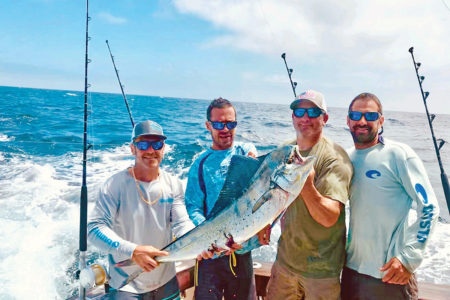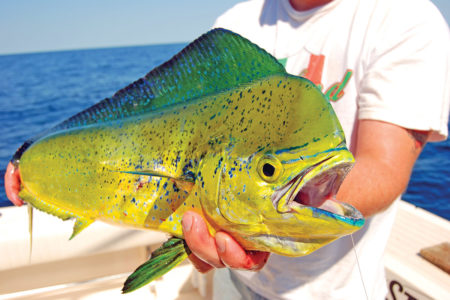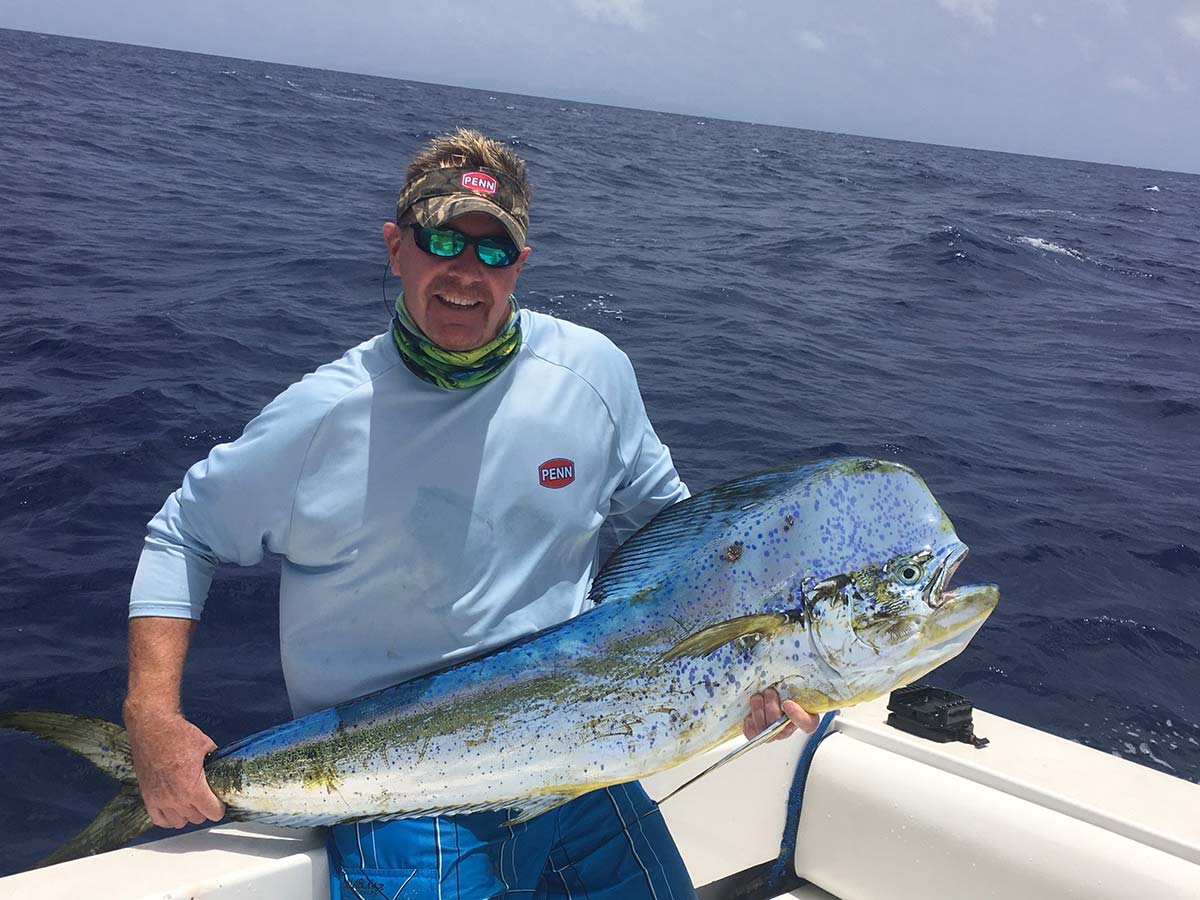
As ocean temps heat up, keep an eye out near those high-flyers and weed lines.
I met up with my buddy Capt. Alvin for a day trip on his 37-foot Calypso center console Emanuel out of St. Thomas for a day of offshore mahi fishing last October. We had become friends over the winter and just started talking about all types of fishing, techniques, and what I can bring him from the U.S. to target mahi Jersey style, just to see how it stacks up against the way he targets them there.
Alvin set up with a simple 7/0 inline O’Shaughnessy hooked to a dead goggleye sliced just above the tail and all the way up the backbone to just below the head to keep the fish upright and skipping on the surface. The classic O’Shaughnessy hook has been an all-time favorite with saltwater anglers; this forged wire hook is perfect when using long natural baits, such as whole fish heads/tails, squid, or crabs either inshore or offshore, and is ideal for both trolling and stationary fishing. It is a time-tested true all-round hook, which can be used to present any bait for species ranging from sea bass and cod, to bluefish and mahi.
We ventured out using conventional tackle with 30-pound Berkley Big Game mono on Penn Fathoms and Shimano Trinidad reels along with Penn Slammer spinning reels in the 4000/5000 series class. Reels were rigged with 30-pound Spiderwire Blue Camo braid, and 40-pound Yo-Zuri fluorocarbon leader. We agreed to split the trip with his tackle and techniques for the first two hours, with New Jersey style tactics thereafter; but I knew I was at a disadvantage being the away team. There were no signs of weed lines, flotsam, high-flyers, or any commercial gear, so the hunt for dolphinfish was going to be all about current, clean water meeting turbid water, temperature breaks, and finding a single bird or birds.
And Capt. Alvin was good at this!
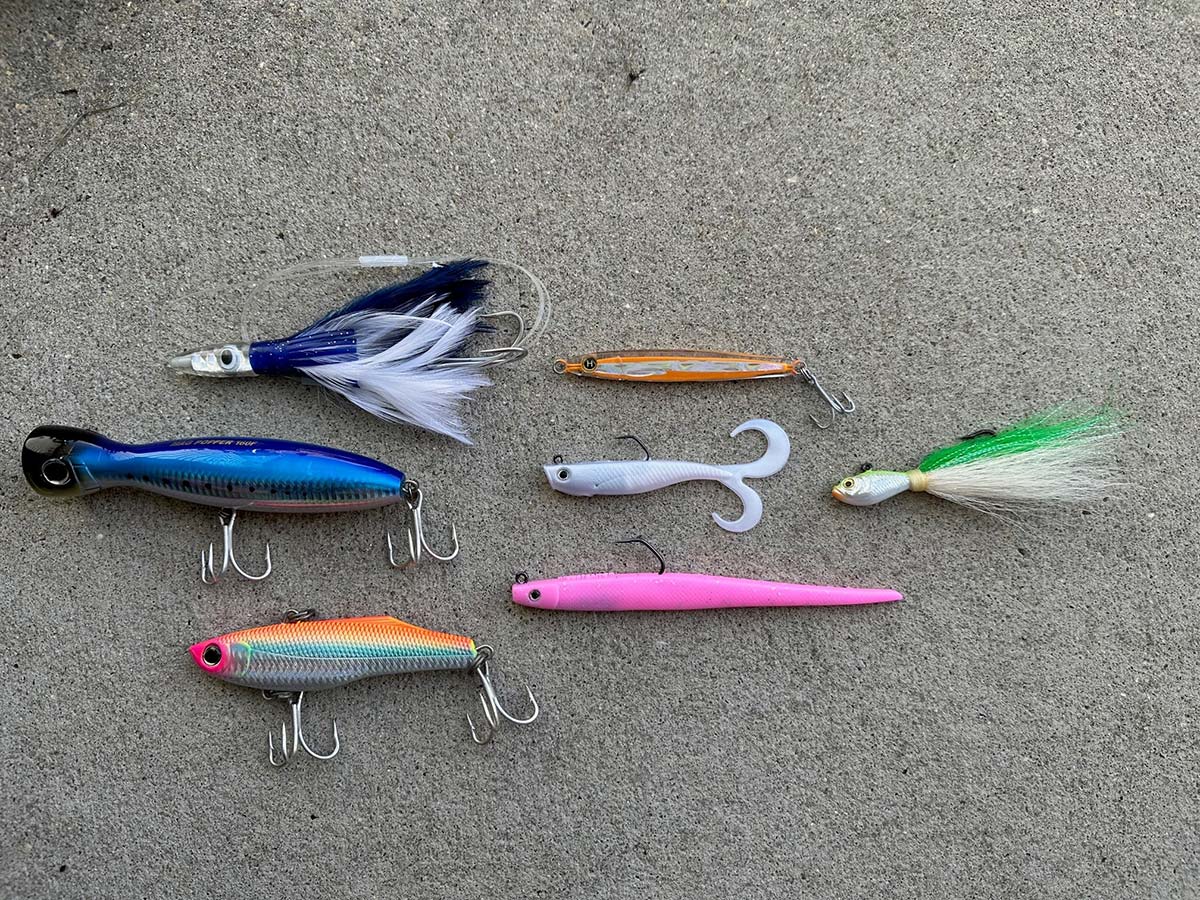
North vs. South
Alvin spotted a single frigate bird patrolling the blue water and we deployed the single bait on the troll which was the only rod in the water with two pitch bait rods on the ready with a single goggleye rigged and ready. Did we hook up? Sure, a beautiful bull and Alvin was feeling all good about himself as I laughed as we exchanged a high five as lunch was caught. We continued to search and landed a few more on this very simple rig and I was impressed with the simplicity of this style of fishing and how well it produced.
He explained to me that he uses one rod to maneuver quickly if the bird takes off in another direction; his eyes were better than mine when following a dolphin as he sees many solo fish in these vast waters unlike in the Northeast where we can see schools working together. “Having a single, fast-skipping bait in the water is like a flying fish fleeing which he sees most of the time and it is sure to get bit as dolphin will compete for this bait,” he explained.
When it was my turn, out came my assortment of feathers, jets, plugs, and soft baits, prompting a wry smile from Alvin. “Let’s do this,” he said gamely, happily engaging this as another way for him to target these fish with something they never saw before. After looking over his maps on his Simard, we fished a tide line near an upwelling that he had driven past on numerous occasions, and it just so happened to have some small scattered pods of weeds. However, I wanted to see if we could find a long line of weeds in an unbroken formation that we could troll blue/chartreuse, and blue/white Islander jets to see if there was life with a rigged ballyhoo.
We deployed the two Islander spread and tried various trolling speeds between 2 and 9 knots, and we produced two small mahi which we released along with a beautiful bull on a Yo-Zuri high speed vibe that I placed down the middle of the spread. Capt. Alvin was excited to add a new tactic to his arsenal and I was happy to gift him my lures at the end of the trip.
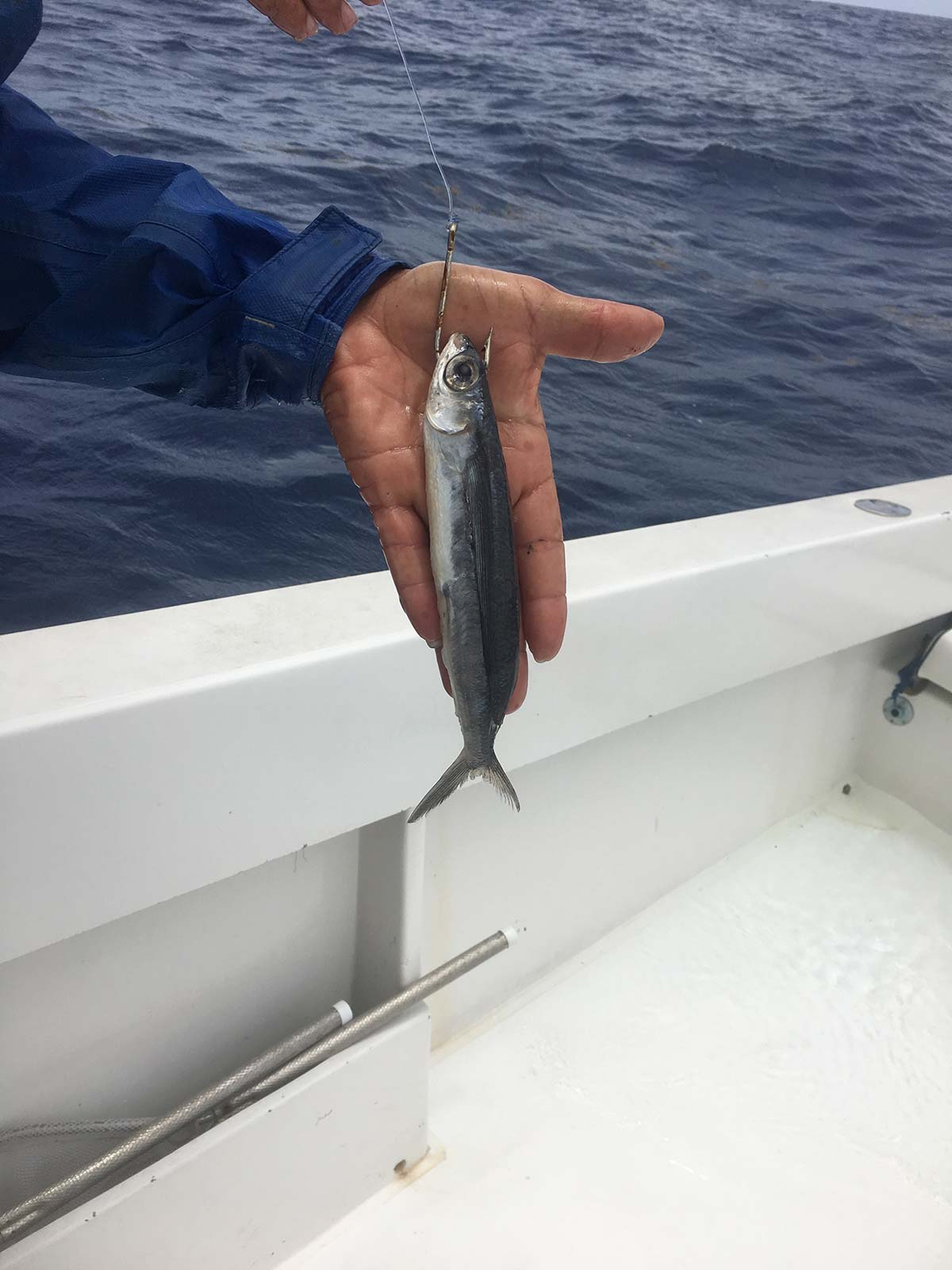
Jersey Tactics & Tips
The winds and waves picked up in the afternoon, which made reading the water and finding mahi very difficult. Once on land, Capt. Alvin was curious to learn about the tactics we use in New Jersey and home of my Long Run Fishing Charters. We sat down to a fresh mahi lunch, and I brought my assortment of lures and soft baits as we just talked. A crowd gathered at our table as we shared our catch with other patrons and fishermen.
I mentioned how structure oriented our mahi are back here along the Jersey Shore, explaining how lobster pot strings with high flying buoys provide a small ecosystem in our vast ocean where dolphin prey on small bait fish. I told him how we use Yo-Zuri mag poppers, Hogy soft baits, fish cut bait like sardines on 2/0 to 5/0 octopus hooks with fluorocarbon leader and seed an area with live peanut bunkers, cut sardines, and spearing to see if there is any life.
I also explained how we use the ROFFS (www.roffs.com) service for water temperature data and more importantly their data on ocean color/chlorophyll which are part of our daily trip planning. The goal is to find the warmest, cleanest, and areas of water where chlorophyll is present but not to turbid/dirty green (or the mahi cannot see their food). Our commonality was structure but a different kind as well as bird life, clean water, and weed lines.
Targeting mahi in the our home waters here in the Northeast excels when the water temperature rises above the 70- or 71-degree mark, which can be as early as June but can also extend into October if the conditions are right. I use the ROFFS fishing forecasting analyses to help determine how far offshore we have to go to find warmer and cleaner productive waters. Furthermore, these analyses show where the stronger and more stable ocean frontal boundaries are located over good structure. These are the areas where weed lines and bait concentrations are more likely to be located to increase your chances of putting a few mahiin the box.
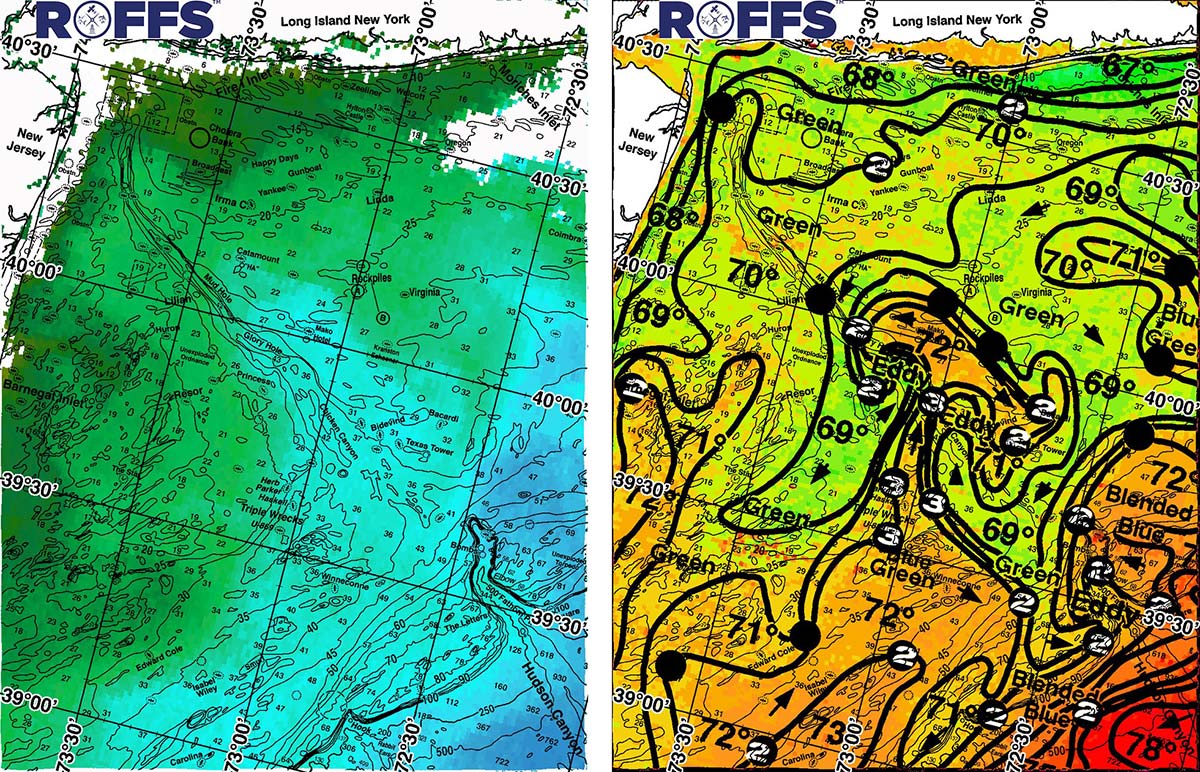
Shore Strong
There are many ways to target mahi-mahi (Hawaiian for “strong strong”) from the use of trolling feathers, islanders, and Sterling Dial Tracker bars, or by fishing hooked cut bait, tossing poppers, or ripping soft plastics and swimming plugs around structure. There is no way you can be too fast on the retrieve to beat these speedsters, and also effective is tossing Spro bucktails from 1 to 3 ounces tipped with a Berkley 4-inch Swimming Mullet or a strip of squid. On our charter trips we mix it up to see what works and carry everything possible to try.
As I had explained to Alvin over lunch in St. Thomas, we approach a high-flyer far enough away with the wind at our backs to drift towards the buoy or weed line. I like to toss a Yo-Zuri Mag Popper to see if I can create a frenzy as the other guys work a Hogy, Spro bucktail, or chunk bait, all while seeding the area with a handful of cut sardines or live peanut bunkers. If there is nobody home, we quickly pot hop to the next one and then the next and repeat the sequence.
If one dolphinfish gets hooked and many follow, we will keep one in the water until another is caught and we remove one and replace it with another, and so on. Mahi will be curious and stick around, so we’ll keep that process going by also tossing in a few pieces of cut bait to keep them engaged.
Safety, knowing your role, and having the right landing tools will keep this bite in controlled chaos as you need to have a good person on the gaff and be able to swing the fish into the cooler or fish box. Trying to remove a single hook as well as treble hooks on a wild, fully lit dolphin is something not to slack on otherwise; you’ll be practicing hook removal at sea and a trip to urgent care for a tetanus shot. For smaller chicken-sized mahi you can get them into a net and control their movement for easy capture or release. I have seen guys with a large garbage can onboard to swing the fish into and removing the hook with long nose pliers or a long handle hook out tool while wearing cut proof gloves. I always wear glasses to protect my eyes from flying hooks and lures and be sure to have a stocked marine first aid kit.
Besides having a broad selection of artificial lures aboard your boat it is always advantageous to have a flat of frozen sardines, rigged ballyhoos, as well as squid. If you can net some peanut bunker or purchase some live killies and fill your live-well, these work great as chum; bait as well as swimming one on a 2/0 octopus hook on 20- to 40-pound fluorocarbon leader.
Taking pictures of these beautifully colored fish must be done quickly as they can go from a vivid yellow, green, blue to a copper color before timing out. As for table fare these are one of my favorites on the grill and I can tell you that the Northeast mahi and the St. Thomas species both tastes delicious! This is truly a fish that provides a solid fight no matter what the size and can be fished for with a broad variety of tackle.
The author runs Long Run Fishing Charters out of Point Pleasant.
